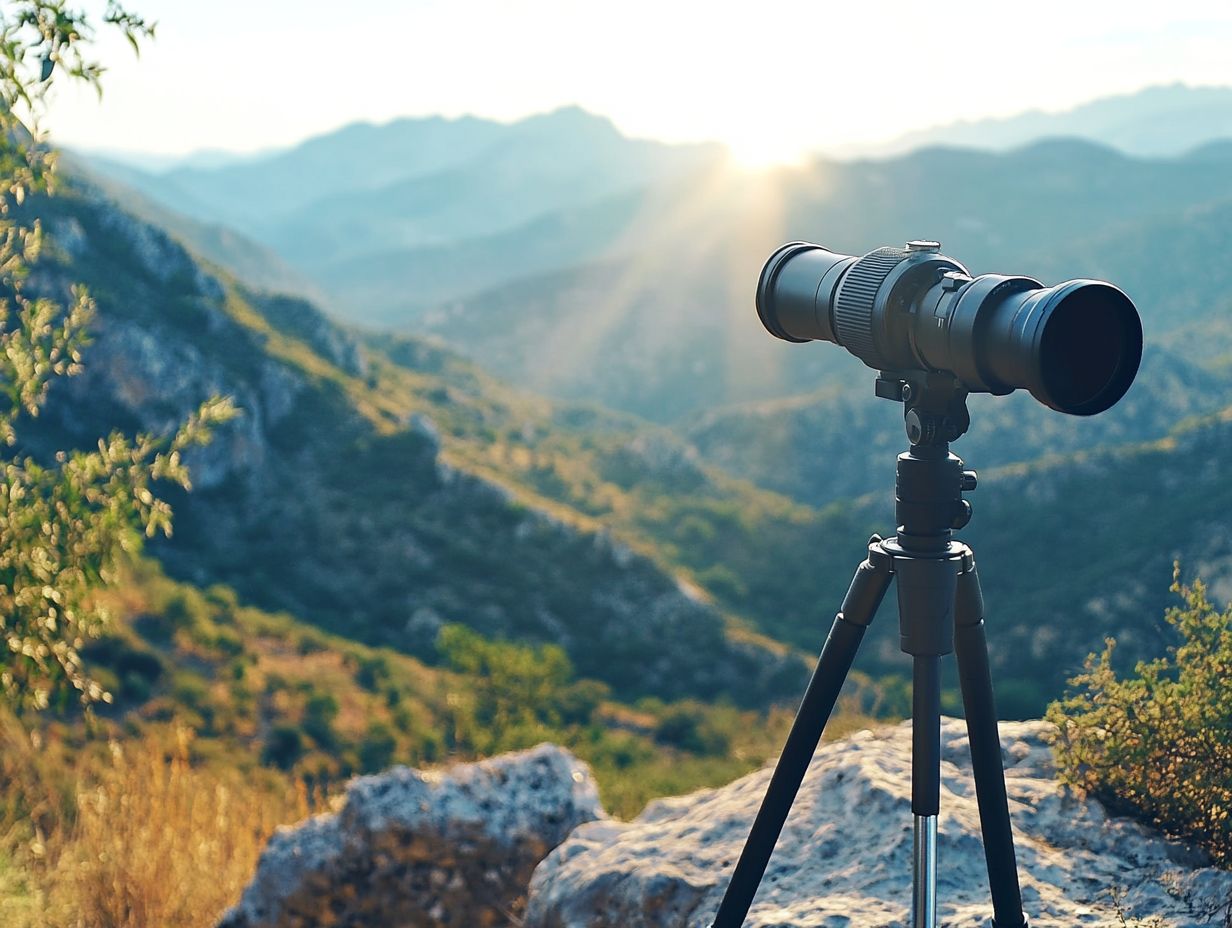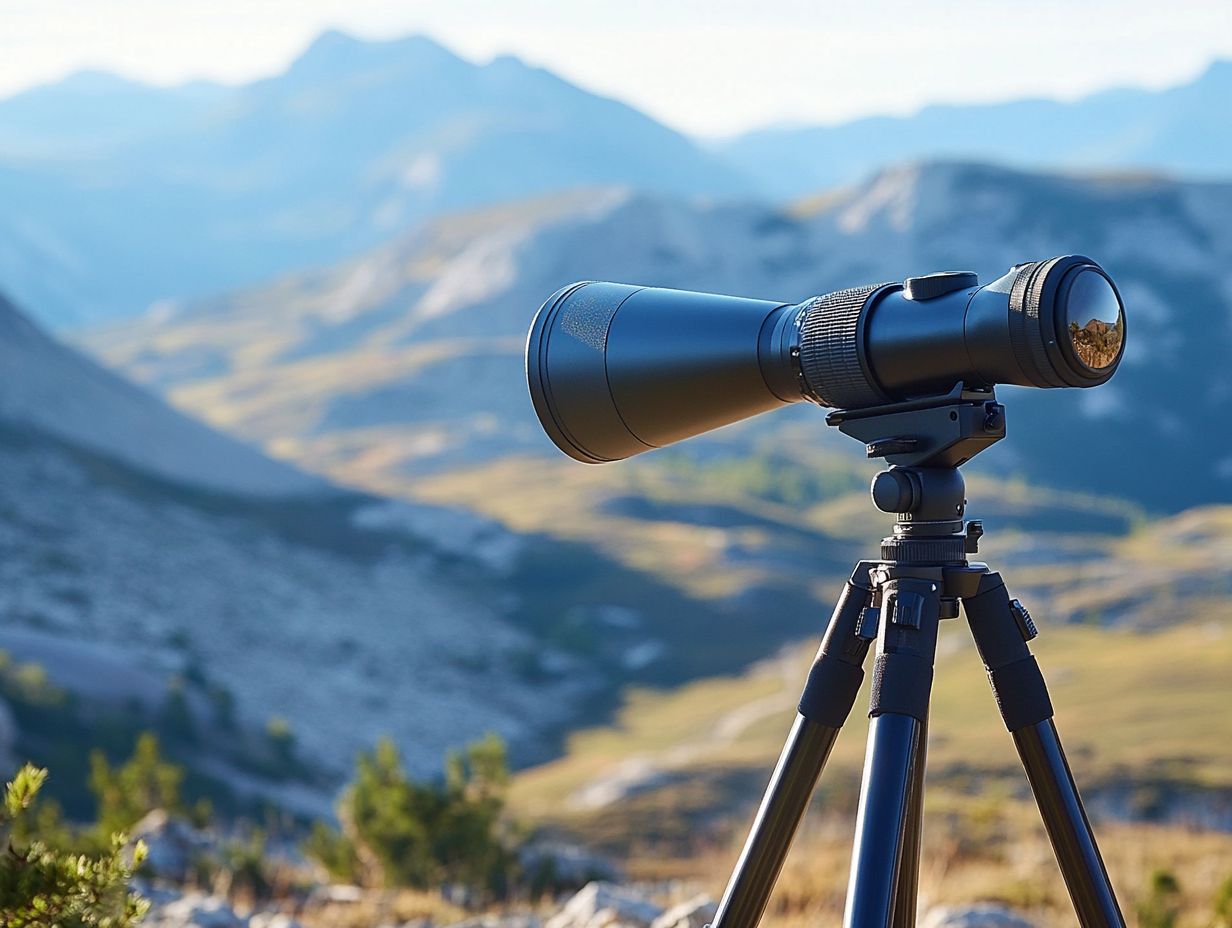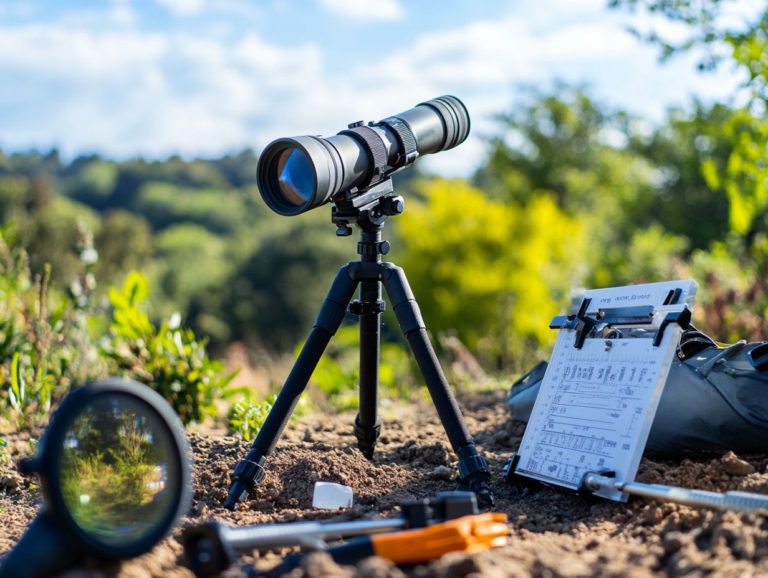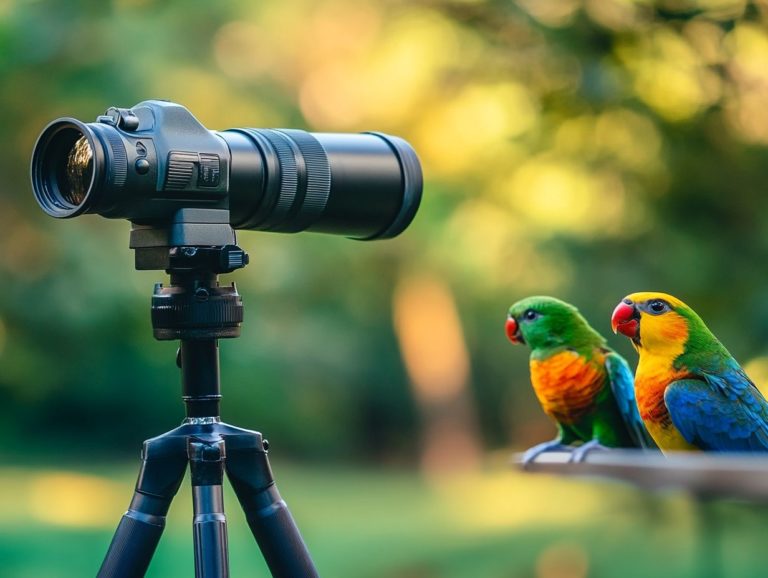5 Things You Didn’t Know About Spotting Scopes
Spotting scopes are often dismissed as mere birdwatching tools, but discover the amazing versatility of spotting scopes! They possess a versatility that may surprise you.
With impressive magnification capabilities, these scopes play crucial roles in astrophotography and long-range shooting. They enrich various outdoor pursuits and showcase how well they see and work. Whether you re captivated by wildlife, intrigued by the cosmos, or invested in hunting, understanding the unique features and applications of spotting scopes can elevate your adventures significantly.
Explore five surprising facts about spotting scopes that just might inspire you to unlock their full potential, including insights on the best spotting scopes available today.
Contents
- Key Takeaways:
- 1. Unlock Incredible Uses Beyond Bird Watching!
- 2. Experience Higher Magnification Power Than Binoculars
- 3. Spotting Scopes Can Be Used for Astrophotography
- 4. They Are Essential for Long-Range Shooting and Hunting
- 5. Spotting Scopes Have Different Types of Prism Systems
- What Is a Spotting Scope and How Does It Work?
- Frequently Asked Questions
- Did you know spotting scopes can be used beyond birdwatching?
- How do you choose the right spotting scope for your needs?
- Do spotting scopes work well in low light conditions?
- Can you take photos or videos with a spotting scope?
- Do I need to clean my spotting scope regularly?
- Do I need any additional accessories for my spotting scope?
Key Takeaways:

- Spotting scopes are versatile tools that can be used for activities like astrophotography and long-range shooting.
- Compared to binoculars, spotting scopes have a higher magnification power, making them ideal for detailed viewing.
- Different types of prism systems are used in spotting scopes, each with its own advantages and purposes.
1. Unlock Incredible Uses Beyond Bird Watching!
Spotting scopes are incredibly versatile optical instruments that go far beyond their traditional role in bird watching. To enhance your outdoor experiences, it’s important to know 5 things to avoid when using your spotting scope, allowing you to engage in various activities, from wildlife observation to landscape viewing. All this is possible thanks to their superior image quality.
These scopes are designed with you in mind. They offer exceptional performance and superior lens quality, making them perfect for both amateur enthusiasts and seasoned professionals.
Ever wondered how spotting scopes change your view of nature? Imagine being a nature lover using these powerful scopes to catch a glimpse of elusive animals in their natural habitats. To enhance your experience, consider these 5 tips for using spotting scopes in low light, which can help you pick up on details that often elude the naked eye, thanks to their advanced optical resolution.
Landscape photographers will find themselves framing distant scenes with remarkable clarity, resulting in breathtaking images that truly showcase the beauty of the natural world.
Whether you re trekking along a rugged hiking trail or relaxing by a serene lakeside, having a spotting scope in your gear can completely transform your experience. You ll appreciate the nuances of your surroundings and connect more deeply with the environment.
2. Experience Higher Magnification Power Than Binoculars
Spotting scopes truly outshine binoculars when it comes to magnification power. Full-size spotters achieve astonishing levels of detail and offer a wider array of magnification options. You might prefer compact spotting scopes for portability or full-size models for more demanding observations.
With magnification levels often soaring between 20x to 60x, or even higher, these optical marvels allow you to capture intricate details of distant subjects. They are invaluable for activities like hunting and wildlife observation, especially with compact spotting scopes.
A compact spotting scope, like a 15-45x model, is perfect for birdwatchers who crave a lightweight option for their travels. Meanwhile, a full-size version, typically delivering 25-75x magnification, is ideal for the serious digiscoper eager to snap stunning images from afar.
Both types enable you to appreciate nature’s finer details that might otherwise slip by unnoticed. Elevate your overall experience in the great outdoors!
Ready to explore? Grab your spotting scope today!
3. Spotting Scopes Can Be Used for Astrophotography
As an astrophotography enthusiast, you can truly elevate your craft by utilizing the exceptional low-light performance and premium glass quality of spotting scopes like the Vortex Razor HD or Nikon Monarch Fieldscope. These instruments become critical for capturing celestial phenomena think distant stars and planets with stunning clarity and detail.
Thanks to advancements in optical technology and special coatings that reduce color distortion and improve image quality, these scopes feature multi-coated lenses that enhance light transmission. This allows you to enjoy striking views even in near darkness, which is a game-changer when photographing faint objects like nebulae and star clusters.
Many models offer compatibility with various eyepiece options, giving you the flexibility to customize your viewing experience to suit your needs. For instance, both the Vortex Razor HD and the Nikon Prostaff 5 are standout choices among astrophotographers. They excel at providing breathtaking imagery of the Moon’s craters and the intricate details of Jupiter’s bands, making your celestial pursuits both rewarding and awe-inspiring.
4. They Are Essential for Long-Range Shooting and Hunting

For long-range shooting and hunting, spotting scopes are critical tools that elevate your accuracy and overall performance in the field. They provide remarkable optical resolution and a variety of reticle eyepiece options, enabling you to spot targets at impressive distances with both confidence and clarity.
By utilizing high-quality optics and innovative features like dual focus, these devices not only enhance your ability to visualize distant subjects but also make quick adjustments for horizontal and vertical adjustments a breeze. For those new to this equipment, understanding spotting scopes can be invaluable. Imagine yourself in a scenario where you need to identify game from several hundred yards away; with a spotting scope at your disposal, you can swiftly differentiate between a legal target and a protected species, ensuring that you adhere to hunting regulations.
In competitive shooting, the advantage of closely examining your target’s details through a well-crafted reticle eyepiece cannot be overstated. This capability significantly sharpens your focus and consistency, ultimately leading to improved performance whether you’re on the range or in the field.
5. Spotting Scopes Have Different Types of Prism Systems
Spotting scopes incorporate various prism systems, like the Bak4 prism, to elevate their optical performance. This provides you with superior image quality and unique design features such as an angled design tailored to your preferences and needs.
Grasping these systems is essential for anyone looking to maximize performance across different lighting conditions and environments. The Bak4 prism system, celebrated for its high light transmission and bright images, often outshines competitors like Porro prisms in brightness and color fidelity. This makes it a favored choice among birdwatchers and nature enthusiasts.
Models such as the Vortex Razor HD and the Celestron Regal M2 showcase the benefits of Bak4 prisms, delivering crisp, clear images with exceptional edge-to-edge sharpness, making them favorites in product evaluations. While other prism types can still perform reasonably well, the advantages of Bak4 technology in image quality are truly remarkable.
What Is a Spotting Scope and How Does It Work?
A spotting scope is your gateway to distant vistas. This advanced telescope is crafted for those who crave clarity at range. With its high-powered design, it allows you to see distant subjects in stunning detail.
Thanks to the exceptional optical and mechanical performance provided by its objective lens and eyepiece options, your experience in the great outdoors is greatly enhanced.
Whether you re birdwatching, hunting, or simply enjoying nature, this versatile tool enhances your outdoor experiences.
Designed for durability and stability, spotting scopes are perfect companions for enthusiasts. They typically feature a large objective lens that gathers light efficiently, ensuring your images are bright and clear.
Choose from various eyepiece options that let you customize your view from intricate close-ups to sweeping landscapes.
Distinctive features, such as waterproof housing that allows use in rain or wet conditions, and protective coatings, mean your spotting scope can withstand the elements. Additionally, spotting scope accessories you shouldn’t miss, like smooth focusing mechanisms and sturdy tripod mounts, enhance usability, setting these scopes apart from traditional binoculars and telescopes.
With a spotting scope in hand, you re ready to uncover breathtaking sights now!
What Are the Key Features of a Spotting Scope?
Key features of spotting scopes include high lens quality, versatile magnification ranges, and exceptional image quality. To make the most of these features, consider exploring ways to enhance your spotting scope experience, which can elevate your enjoyment in various outdoor activities, whether hunting or observing wildlife.
These essential characteristics, including the price/value score, guarantee clarity and detail and allow you to engage more profoundly with your surroundings.
With superior lens quality, enjoy bright, clear images free from distortions, making long-range viewing a true pleasure.
The adaptable magnification ranges and eyepiece options cater to your unique preferences. Effortlessly zoom in on distant subjects or maintain a wider view for a broader perspective.
Robust image quality enhances contrast and color accuracy, ensuring every outdoor experience is vibrant and immersive whether you’re observing birds in flight or tracking an animal during twilight.
How Do You Choose the Right Spotting Scope for Your Needs?

Choosing the right spotting scope begins with a clear understanding of your needs and preferences. You might find it helpful to refer to these 5 tips for spotting birds with a scope as you consider whether you need compact scopes for easy portability or full-size options that deliver exceptional optical performance, all while keeping an eye on your budget.
Think about the primary activities you’ll engage in with your spotting scope. Whether it’s birdwatching, hunting, or catching the excitement of sports events, these factors will heavily influence your decision.
If you re seeking something easy to transport, lightweight and compact models like the Vortex Optics Diamondback 20-60×80 are perfect, offering outstanding quality in a portable design.
On the other hand, if superior visual clarity over long distances is your priority, the Leupold SX-4 Pro Guide HD 20-60×85 will impress you with its remarkable brightness and detail.
If you’re mindful of your budget, exploring entry-level models like the Celestron Ultima 80 can be a smart move, allowing you to maintain quality without breaking the bank.
What s your favorite outdoor activity where a spotting scope could enhance your view?
What Are the Different Types of Spotting Scopes and Their Uses?
Spotting scopes come in various types, including those with angled designs, crafted for specific uses like wildlife observation or hunting. This ensures you can choose the perfect option for your outdoor pursuits.
Among the popular choices, angled scopes offer a distinct advantage for birdwatching enthusiasts. They provide more comfortable viewing angles during extended use. Models such as the Vortex Diamondback HD are favored for their versatile magnification ranges and exceptional light-gathering capabilities, making them ideal for low-light moments.
For hunters, compact designs emphasizing portability are crucial. Take the Nikon Prostaff 5, for example; it features weatherproof construction, perfect for rugged outdoor conditions. Additionally, for those interested in birdwatching or stargazing, understanding spotting scope optics is essential, as some scopes are tailored specifically for stargazing, combining high optical quality with adjustable eyepieces to enhance your celestial observations.
Every spotting scope type opens up unique adventures waiting for you!
What Are Some Tips for Taking Care of Your Spotting Scope?
To maintain the quality of your spotting scope s lenses and ensure its mechanical performance, adhere to a few care guidelines. This will guarantee longevity and optimal performance in all outdoor conditions.
Regularly clean the lenses for the best results. By utilizing a microfiber cloth and a suitable lens cleaner, you can effectively prevent scratches and smudges that might compromise your visibility. Storing your scope in a protective case safeguards it from moisture, dust, and physical damage.
When handling your scope, always use both hands and avoid touching the glass. This simple practice minimizes the transfer of oils from your fingers, which can obscure your images. By embracing these practical tips, you ll elevate your viewing experience and keep your equipment in prime condition for years to come. Start maintaining your spotting scope today for the best viewing experience!
How Can You Use a Spotting Scope for Wildlife Viewing and Photography?
Using a spotting scope for wildlife viewing and photography enhances your experience, offering superior image quality and the chance to take photos through the scope, capturing breathtaking images of animals in their natural habitats.
This technique allows you to attach a smartphone or camera to the scope, transforming it into a powerful telephoto lens that brings distant subjects into sharp focus. To get the most out of this method, consider the optical quality of the scope, the stability of your tripod, and the appropriate eyepiece settings.
Utilizing a sturdy mount can significantly reduce vibrations, ensuring your images remain clear. Setting the scope to a lower magnification in bright light helps maintain sharpness while providing a wider field of view, making it easier to track moving wildlife. Experiment with various lighting conditions and backgrounds; this can lead to captivating photographs showcasing the animals’ behaviors and environments.
Frequently Asked Questions

Did you know spotting scopes can be used beyond birdwatching?
- 1. Spotting scopes are not just for birdwatching or hunting. They can also be used for activities like stargazing, target shooting, and even landscape viewing.
- 2. Spotting scopes are more powerful than binoculars, with magnification ranging from 15x to 60x or even higher.
- 3. Spotting scopes often have interchangeable eyepieces, allowing you to adjust the magnification for different viewing needs.
- 4. Spotting scopes have a narrow field of view, making it easier to zoom in on a specific target or subject.
- 5. Spotting scopes are designed to be used with a tripod for stability, ensuring clear and steady images.
How do you choose the right spotting scope for your needs?
When choosing a spotting scope, consider factors like magnification, lens quality, and durability. It’s also important to think about the intended use of the scope, including field testing your spotting scope and whether you need additional features such as waterproofing or angled eyepieces.
Do spotting scopes work well in low light conditions?
Spotting scopes have larger front lenses than binoculars. This allows them to gather more light, improving performance in low light situations.
To see a real difference, invest in a high-quality scope with effective lens coatings.
Can you take photos or videos with a spotting scope?
Yes! Many scopes work with camera attachments, letting you capture stunning photos or videos of what you see.
Just keep in mind, the quality might not match that of a dedicated camera lens.
Do I need to clean my spotting scope regularly?
Keep your spotting scope in top shape by cleaning it regularly! Use a soft, lint-free cloth to wipe the body and lenses.
For stubborn smudges, use a specialized lens cleaning solution. Stay away from harsh chemicals that could damage the lenses.
Do I need any additional accessories for my spotting scope?
While optional, some accessories can enhance your experience. Consider a tripod for stability, a carrying case for protection, and lens filters for various lighting conditions!
A lens cap is also a smart investment to safeguard your scope when not in use.






